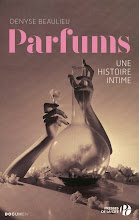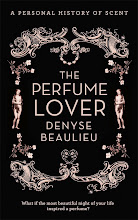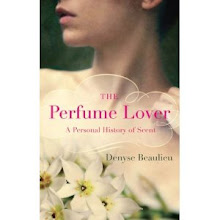
It’s been three years now since Chanel launched its Les Exclusifs collection, a line dedicated both to preserving the house’s heritage – with four Ernest Beaux from the 1920s – and to pulling it into a contemporary style of perfumery which I think of as “materials-driven”. Thus, 28 La Pausa was a study of the iris that has infused classic Chanels, from Cuir de Russie to N°19, with its haughty elegance. Bel Respiro softened N°19’s resinous galbanum glint with grassy notes. Coromandel pared down and smoothed Coco’s opulent patchouli. The startlingly original N°18 teased out the crystalline glints of ambrette buried in Bois des Iles’s mouthwatering richness…
A tribute to aldehydic florals was considered and abandoned: Jacques Polge told me he could find no way to bring something new to a line that already featured N°22. The Eau de Cologne, he felt, was a nice addition – at the time, he asked me whether I thought he’d taken the right decision, which I did: it’s really one of the very loveliest colognes on the market, and I would swim in it in summertime.
31 rue Cambon is a little harder to peg in a collection that reprises and modernizes the Chanel codes, much like Karl Lagerfeld did by playing on the scale and shape of the double C, the quilted bag, the black-tipped shoes, the camellias, the chains and faux-pearl necklaces or the black braids on off-white tweed; by fractalizing Chanelitude until every one of his collections was imprinted with its signs.
Though two of the three launches that occurred during in-house perfumer Henri Robert’s tenure were chypres – Pour Monsieur and Cristalle, N°19 being perhaps a borderline case – it seems Gabrielle Chanel herself didn’t particularly like the genre. And 31 rue Cambon plays odd games with it. The scent is designated as a chypre despite the absence of oak moss; arguably, with its bergamot top note, delicate jasmine and amber heart and patchouli base, it does reprise the chypre structure, interpreted in what you could call Jacques Polge’s signature peachiness. Not peach as a note, but as a form: the soft fuzziness of the skin, the melting delicate fragrant flesh, and then a tough little kernel rasping against the teeth.
In 31 rue Cambon, iris and pepper act out that inner toughness that is part of the DNA of chypre, and certainly a trait of the Chanel character. The combination of the two notes conjures the smell of leather. The pepper itself – which Henri Robert, according to his nephew Guy Robert, classified with patchouli amongst the musty notes rather than as a spice – shoots the composition through with acrid, gunpowder facets. Hooked up on top with the pepper aspects of bergamot – pepper also has lemony facets – and at the base with patchouli through its camphoraceous and terpenic facets, the pepper note darkens the mellow blend, summoning the ghosts of bygone chypres…
In fact, it’s as though that ghost of a chypre were teasing my memory: when I wear 31 rue Cambon, I keep smelling hints of what cannot possibly be on my skin – a flash of Aromatics Elixir, a memory of Bandit, a quote of Mitsouko. 31 rue Cambon resembles none of these – its closest relative in the chypre family could possibly be the defunct and much meatier Que Sais-je? by Jean Patou.
This chypre haunting has set me thinking about the way we perceive fragrances. Suppose we smell bergamot in a fresh composition: bergamot summons Earl Grey tea, and hence, our brain summons the idea of a “tea” note from its olfactory library. This happened to me recently when I was smelling Déclaration Cologne with Mathilde Laurent. I thought it smelled like tea. Mathilde answered that I wasn’t the first to make the comment, but that there was no tea note in the blend, or anything that could create a tea accord. My brain, registering the bergamot, had simply conjured a tea illusion. Of course, it did help that the original formula – to which Mathilde essentially just added ginger – was Jean-Claude Ellena’s: olfactory illusionism is at the core of his method.
Similarly, by alluding to the codes of chypre without actually being one, 31 rue Cambon manages to wind its way into the family much more evocatively than any of the Narciso Rodriguez For Her type neo-chypres, and to add another chapter to the story.
Illustration: Coco Chanel in 1913 as seen by Karl Lagerfeld in the Paris-Moscou short feature.




 L'actu
L'actu 


Brava, Denyse. A fantastic and thought provoking essay. And I loved the idea of Lagerfeld's "fractalization of Chanelitude." Back to this idea of perfume as a deployment of olfactive signs, always referencing and refiguring what has come before, and creating new possibilities for what will come after.
RépondreSupprimerWhat is fascinating to me is the process by which the "chypre code" must have gotten established. We must have experienced years of chypres, from which we as a culture developed some consensus of what constitutes "chypritude" (chypre, sui generis). Not just a matter of the actual ingredients, but more subtly, an implicit network of signs and impressions that signal "chypre." And then *poof* something comes along that says "chypre" without what we thought had been the sine qua non, revealing to us that what we thought was "chypritude" was just a simulacrum.
The case of Déclaration is interesting too, because I perceive it as sharing some DNA with Ellena's Eau parfumée au thé vert for Bvlgari. When I smell it, it seems to create the impression of tea without actually smelling anything like green tea. But I think its structure has been borrowed so much over the past almost 20 years and labelled as "tea," that it has become tea, without really having been tea in the first place.
Jarvis, of course, the "chypre illusion" can only work with people who've actually experienced chypre. To others, 31 can work just fine on its own terms.
RépondreSupprimerAs for Déclaration, JC Ellena wrote the original template (the Bulgari), which was widely copied, and which he must've elaborated on with the later Cartier scent.
Clearly, the tea aspect still comes out even in the flanker: according to Mathilde Laurent, it must be because her addition of ginger serves to highlight differently the characteristics of the original formula (which she didn't touch).
JC Ellena is very explicit about his work on olfactory illusion (and indeed on the specific "tea" illusion) in his book.
I haven't hesitated to call 31 rue Cambon a chypre, but I've also qualified that one way or another every time I did. I kind of like the idea of a perfume tricking me a bit, further proof that perfume can be smart. It's a goreous fragrance, whatever you call it, but I have to admit I don't think I've touched my decant since he EaS muscled its way into my life.
RépondreSupprimerAmy, perfume can definitely be smart! Of course, L'Enlèvement au Sérail is much more of a classic chypre (I find it very close to Patou Que sais-je), to the point that I'm wondering whether FK didn't lift the formula somewhere. It's so unlike much of his usual production... Not that I'm complaining.
RépondreSupprimerI think the aspect I like the most of 31 is the similarity with so many of the greats - the richness of Diorella, the peachiness of Mitsouko, the iris of Cuir de Russie. That's also the downside for me - the Attrape-Coeur amber in the base pretty much ruins the whole experience when it sets in. I try and try again to love it, but I just can't...something is missing.
RépondreSupprimerHave you reviews Declaration Cologne yet? If not, please do! *off to look*
Dane, Attrape-coeur is one of my great loves, but I don't feel it has the same texture or richness in the Chanel, where it's melded into the jasmine. Of course, I do know that when you pick out a note that bugs you, that's that.
RépondreSupprimerI haven't reviewed the cologne: it just sort of popped up in the conversation with Mathilde the last time I saw her. But why not? She's pretty much already given me the interview on it, though informally and with just my scribbled notes to go on...
Thanks for this. I've had a post in the works for a while now following a related train of thought about chypre as a kind of genetic code that can be seen or felt in flashes beyond the classic structure or bergamot/oakmoss. Since I came to perfume only a few years ago, when it was, for all intents and purposes, in a post-chypre moment, it was a category I had to deliberately learn rather than one I absorbed naturally by smelling it on the women around me. Because of my initial confusion, I came to think of chypres as a feeling or form as much as specific set of notes. So there are perfumes that feel to me as though they have chypre cheekbones, even though they are supposed to be orientals. In fact, I associate chypre in general with bone structure--or just structure: tailoring, hauteur, haute couture...
RépondreSupprimerGoodness--forgive the typos and tangles. And I see I should have read Jarvis' post more carefully before I wrote mine--chypritude--exactly!
RépondreSupprimerAlyssa, to me chypre does have olfactory qualities: a sparkling overture, dark earthy base and amber-floral heart. There need to be those types of notes for there to be chypritude, but they don't necessarily have to be the classic materials.
RépondreSupprimerThe key element, as you say, is structure: chypre is a rather corseted genre.
Ce commentaire a été supprimé par l'auteur.
RépondreSupprimercarmencanada, didn't know you were into fractals! LOL
RépondreSupprimerHere in the US the people at Chanel talk about powdery fruity floral but not chypre - is this because they're ignorant or they assume the clientele is ignorant or because "chypre" sounds too negative in a "old lady" sort of way? It's got to be something like that.
The new Cuir de Russie bears no resemblance with the original parfum - where is the buttery smooth leather with hints of dry cool frosty notes that intoxicates the senses? The current edt smells like a fizzy humid floral mess, the leather is left to the imagination.
Moon Palace, I'd assume most Chanel customers wouldn't know a chypre if it bitchslapped them. So there's no point in selling 31 as one. Fruity powdery floral, now that's a good sales pitch.
RépondreSupprimerI like the current Cuir de Russie better than you do, apparently. We've got IFRA to thank for the new formula, but to me, it's still the best currently available leather. Then again, I'm not into rough leather scents, and I do get the frosty iris in it.
Sales pitch are intellectually dishonest, they're not facts. The marketing people know it's better to approach the issue from the customer's perspective and not serious knowledge foundation.
RépondreSupprimerI get CdR's frosty iris, it's quite nice but it lacks the velvety luxurious feel I experience in the vintage parfum.
I love dry leather chypres: Empreinte, Sikkim, Azuree, you name it!
Absolutely gorgeous post, as always. And thank you for identifying that elusive 'thing' (not quite scent - more an intimation of scent?) that has teased me since I first visited 31RC - it's the Aromatics Elixir that I can wear, the Bandit I can love - yet, of course, it is so much more.
RépondreSupprimerif this comes in extrait, I am lost!
xoAnita
Great essay, thank you!
RépondreSupprimerWhat do you mean by "materials driven" perfumery?
Heidi
Moon Palace, I love the dry leather chypres too but it's the fruity chypres that suit me best -- Mitsouko's spawn, as it were. Of course, give me vintage Bandit and I can do the tough chypres too!
RépondreSupprimerAnita, there was some talk a couple of years ago about a 31RC extrait: Jacques Polge told me they were considering it, but clearly, they didn't go ahead.
RépondreSupprimerIt's JC Ellena's book that helped me clarify the idea of using memory -- or even tricking it -- into olfactory illusions. I find it fascinating, and hope to be able to dig into it further some day.
Heidi, "materials-driven" perfumery is a term I've coined to designate the contemporary style of building a fragrance around the specific qualities of a raw material. The Hermessences are the best case in point, but some of the Chanel Exclusives also work that way (which Jacques Polge confirmed to me), the L'Art et la Matière collection from Guerlain, some of the Serge Lutens (Tubéreuse Criminelle, Iris Silver Mist, the Bois series), etc.
RépondreSupprimerReading these two discussions on the term "chypre", I feel better: classification is always a tricky job (ah, subjectivity!), and I'm glad I'm not the only one a bit confused...
RépondreSupprimerI get especially surpired when I discover that some of my favorites floral-orientals are classified as "nuoveau chypres".
31 rue cambon, was a floral (and a bit fruity) oriental to my nose... but I'm talking here of a general impression conveyed by the fragrance, rather than its structure.
Of course, I must be wrong, since the belonging of 31RC to the C family seems given for granted.
But when I think chypre, I think of mitsouko and its siblings, I think of bright tops on a musty, dusty backdrop...I think of thick shimmering dark velevts and lack of air space and I think not me.
So, BTW, would you classify L'amoureuse and Une rose chyprée, two fragrances I like very much, as chypres? To me, they are both (honeyed) floral orientals.
There are only two recent perfumes that convey to me the same musty shimmering feeling of Ol' Mitsy: Manoumalia and Oeillet from the Prada exclusive line. Are they "Nuoveau Chypres"?
Though passionate, I fear I'm proving myself very ignorant once again :( ...
Zazie, the discussions around classification are not necessarily subjective, it's just that different authors establish different criteria. Michael Edwards, for instance, doesn't use chypre in his classification.
RépondreSupprimerAmoureuse used to be a chypre, but it's been de-oakmossed recently. I don't know about the Rose Chyprée because I don't know Andy Tauer's perfumes: they're not available in Paris.
I wouldn't class Manoumalia or Oeillet in the family: both to me are floral, though the first does have a darkness due to the vetiver.
Not all chypres are "airless": think of Diorella for instance, or Le Parfum de Thérèse.